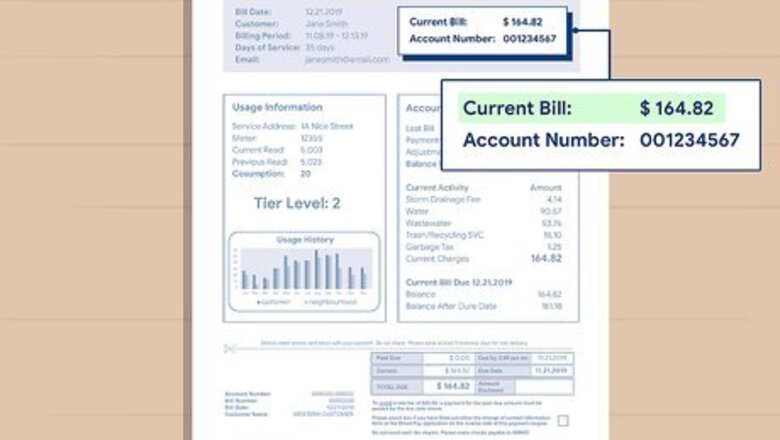
views
Locating Essential Information
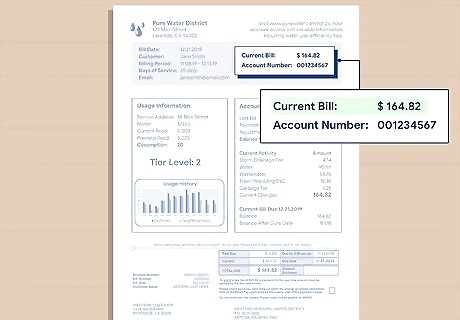
Find the payment total at the top of the bill. Look on the top ⅓ of the bill paper to see your payment for the month. While the format will differ depending on your billing company, you can usually find the surcharge in bolded text in a prominent section of the bill. Try to find this information first, as it’s the most important part of your water bill. Some companies use the term “Total Account Balance,” while others will say “Total Amount Due” or “Total Current Charges.” If you have an overdue payment from a previous month, that additional bill will be included in your total charges.
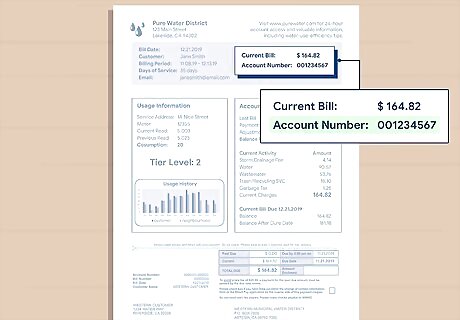
Search near the payment for your account information. Before filling out the payment form, check that all of your personal information is listed correctly on the bill. Near the top of the form, look for your name, address, email, phone number, and account number. If any of this information looks incorrect, contact your water billing company right away. If the wrong address is listed, there’s a chance that your water usage isn’t being recorded correctly. Some companies will list how long you’ve been a customer.
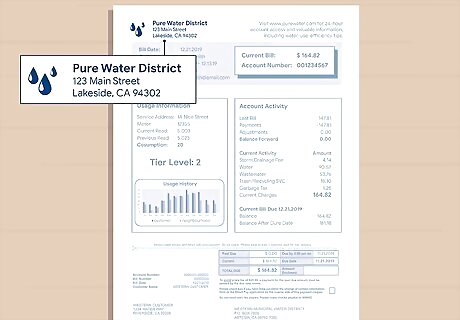
Spot the billing company’s contact information near the top. Look in the top-left corner of your water bill to find the logo and company name of your water provider. Take note of the business’s address, as well as their website and phone number. If you have any questions about your bill, use these lines of communication to reach out. Some water providers have a specific hotline for payment options.
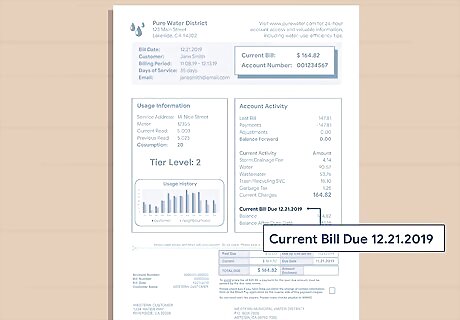
Double-check the billing date on your form. Search near the “Total Amount Due” to find the deadline for your water bill payment. Try to submit the payment by the specified date; if you don’t, you may be issued a late fee, or the charges could carry over to your next water bill. If you aren’t sure when your water billing cycle begins and ends, check the “billing period” on the form, which is listed near your account information. Some bills will specify when the bill was mailed out, which can help give you a more accurate payment timeline.
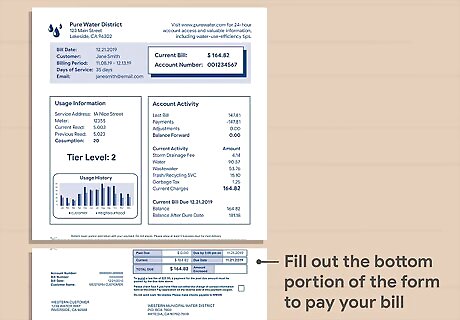
Cut off and fill out the bottom portion of the form to pay your bill. Use a pair of scissors to remove the payment portion of the payment form. Place this slip, along with a check, in an envelope addressed to your water provider. When filling out your check, follow the instructions provided on the water bill to make your payment out to the correct group. Only mail in the bottom portion of the bill. You can save the top ¾ of the document as a receipt, if you’d like. Checks are a common way to pay your water bill. When using this form of payment, be sure to record the check number and date paid on the receipt. Check online to see if your service provider accepts payment through credit card. If so, use the online portal provided to input your card information. As a reference, jot down the confirmation number of the digital payment as well as the date you paid it.
Assessing Your Water Usage
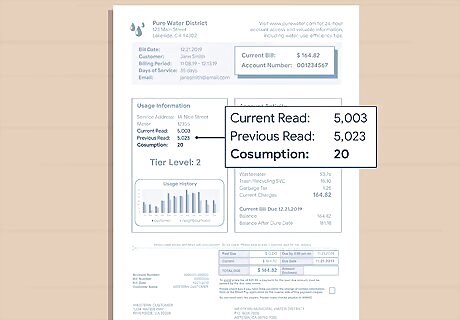
Find the usage charges to see how much water you used. Look beneath your base service charge to see how much water your household used throughout the billing period. Note that most companies use centum cubic feet (CCF or HCF) to measure water usage, with each CCF having a unit cost. One CCF or HCF is equal to 748 gallons (2,830 L) of water. For example, if your water provider charges $3 for every CCF of water used, then the total amount of water you use each month will be multiplied by that base amount. If you use 15 CCF of water during a billing period, you’ll be charged $45 on your water bill. You can also find the water meter reading in the usage section of your water bill. This can give you a more exact idea of how much water you used.Did you know? Most American households use at least 300 gallons (1,100 L) each day. During the summer, this amount increases to almost 1,000 gallons (3,800 L) per day.
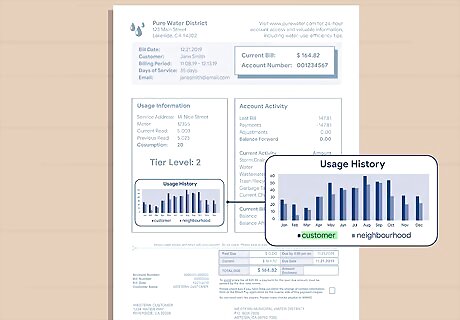
Examine the provided graph to see your monthly water usage. Search in the middle of your water bill to find a bar or line graph detailing your monthly water usage. Check the X-axis of the graph to view the water usage of a specific month, and the Y-axis to determine the total CCF of water. You might also see a projected estimate included in the graph. This graph is a great way to monitor your water usage and make changes in your household for future months.
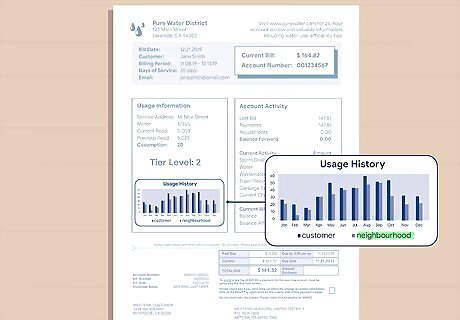
See if your bill includes a graph of your neighbor’s water usage. Check for a more complex graph, which uses a bar graph and line graph to compare your water usage to your general neighborhood. Follow the graph key to see which tier you fall under, as compared to your neighbors. This doesn’t include data on specific households, but gives you a general idea of how much water you use compared to others nearby.
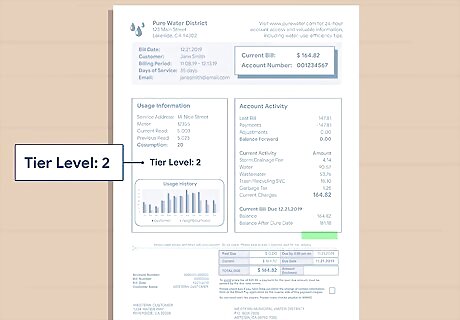
Study different tier levels to see how well you manage your water. Scan the middle section of your water bill to find a chart of 5 different tiers. Next, examine the chart to see which tier your household falls into. In future water bills, try to fall into tiers 1 or 2, which shows that you don’t use too much water. If your water usage falls into tier 3 or above, then you‘re using unnecessary amounts of water. Extra, unnecessary water usage can increase your water bill. Not all water bills will include a tier chart.
Reviewing the Different Fees
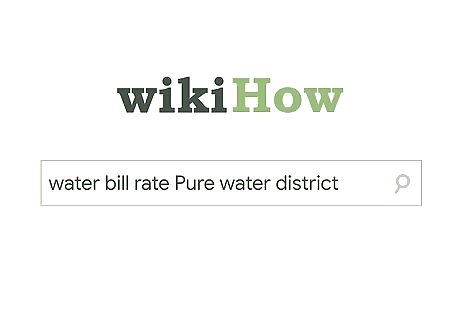
Check online to see which rate plan is used to charge your water bill. Depending on your water provider, you might have a uniform, increasing, or seasonal rate that determines the cost of your water. Go to water bill section of your town or city’s website to see if you’re charged at a uniform, an increasing block, a declining block, or other type of rate. If you can’t find the exact information, call your water provider directly so you can find out. A uniform rate has a constant, unchanging price for each unit of water, while increasing and decreasing block rates change throughout the year. Seasonal rates charge you on a bimonthly basis, and are used to motivate customers to save water. Drought rates, on the other hand, change depending on how much water is available. Some providers might use a Water Budget Based Rate, which charges based on the size of the household and property.
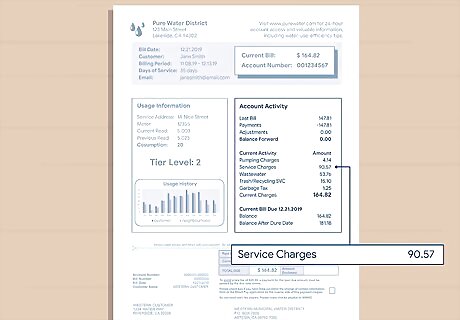
Look at the service or system charge to see your basic utility costs. Search along the middle of the form to find a list of different fees, taxes, and other charges related to your water bill. At the top of this list, find a fee that’s labeled as a “Usage Charge,” “Service Charge,” System Charge,” or something similar. Note that this fee is a base payment to your water provider, and doesn’t have to do with your water usage. Many providers charge by a daily basis, then multiply this daily fee by the number of days in the billing period. For instance, if a billing company charges $0.50 on a 30-day cycle, then your service charge will be $15.
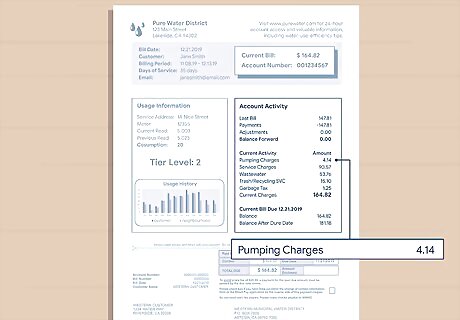
Note that pumping charges have to do with your home’s location. If you live in isolated or elevated place, you might have additional pumping charges show up on your bill. Like your usage fee, a pumping charge has a unit cost for every CCF of water. For instance, if your water provider charges $0.15 to pump 1 CCF of water to your home, this unit cost will be multiplied by the total CCF of water that you use each month. Usage and pumping charges are calculated using the same data; however, pumping charges are far less expensive than usage charges.
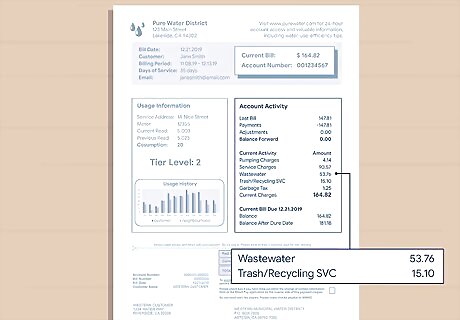
Identify any sewer service charges on your water bill. Note that most water companies include a base fee for regular sewer maintenance, as well as additional sewer service fees. Depending on where you live, you might also notice a charge for storm drain maintenance in your bill. Generally, these additional sewer charges are calculated after sewage from your home’s sewage system is processed, filtered, and analyzed. If your household generates a lot of sewage, your additional charges will probably be higher.
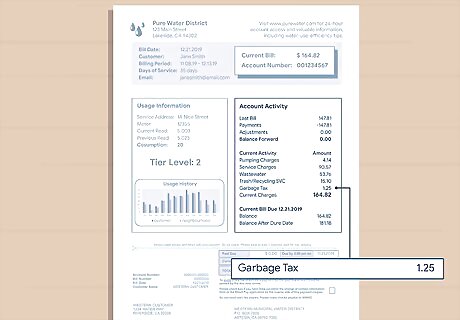
Search for additional charges and taxes on the bill. Depending on your region, you might have extra taxes and charges added to your bill. If you don’t recognize these charges, visit your city’s official website for more information on your water bill. For instance, some cities add safe drinking water loans, purchased water fees, and groundwater fees into the total bill.















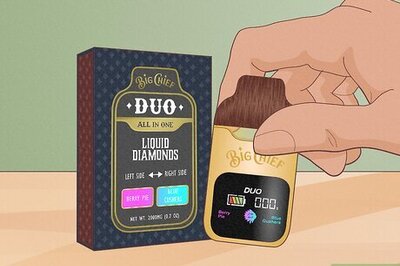

Comments
0 comment